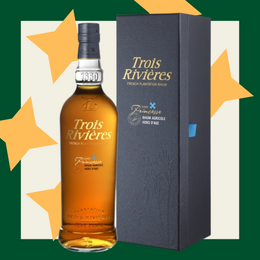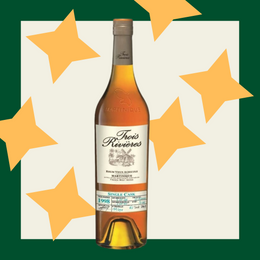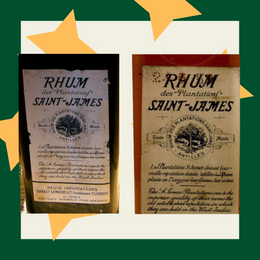Taste Testing Bacardi Rums Through The Ages: Bacardi Facundo Paraiso; Bacardi Anejo c.70’s / c.80’s; Bacardi Carta de Oro c.40’s / c.50’s; Bacardi Carta Blanca c.80’s; Bacardi Premium Black 80’s

Bacardi | the empire
On the historical side, Bacardi needs no introduction, founded by Facundo Bacardí Masso in Santiago de Cuba on February 4, 1862; all the media are full of more or less juicy details about this saga. On the production side, it is a little less precise, but we know that in 1862 Don Facundo Bacardi and his partner at the time (José Bouteiller) bought the Nunez distillery in Santiago de Cuba, isolated a strain of yeast (which is still used today), and distilled their first rum using an old still (discontinuous distillation) of English manufacture equipped with plates and rectification, before filtering the finished product.
In 1911, Bacardi shut down its old still after nearly half a century of loyal service; made of "copper and iron", it produced 35 barrels of fermented molasses per day. It was replaced by a more modern double column of the Coffey type: then very recent in the world of distillation, it was the very first column of this kind in Cuba, and the story goes that the company was so pleased with the purity and lightness of the newly produced rum that it decided to completely stop using stills. The machine was launched, already making Bacardi a fully-fledged player in rum production. After having acquired a certain base and following the political instability of its country, Bacardi transferred its activities in 1958 to Puerto Rico (San Juan), the opportunity to take on a larger international scale this time. Over time, the San Juan distillery became the center of the latest technologies, and quickly the double Coffey column no longer met the distilleries' desires for expansion, giving way to the Multiple Columns, perfect tools for exhausting rum to make it even lighter than light. Bacardi installed a quadruple rectifier column and thus moved into a new era, that of industrialization in order to meet a constantly increasing demand. Like so many other distilleries, Bacardi had to adapt over the course of its history, abandoning traditional methods that could no longer suffice for its desire for expansion.
Today, Bacardi has many distilleries located all over the place and sells more than 180 million liters of rum each year; enough to understand a little more the industrial side of this brand that everyone keeps selling through its history without unfortunately ever dwelling on the production itself and the characteristics of its products. However, this is a minimum because it is indeed the rum that is drunk, but many will undoubtedly prefer to continue to sell dreams instead of talking about reality, and to make people believe that today's Bacardi is even better than the old one, technological prowess surely...

--------------------------------------------------------------------------------------------
The Bacardi Empire | Date Time
The photos below give an overview of the changes that have occurred over time, in addition to being a valuable aid to dating, even if according to other sources they do not quite match reality. To be used sparingly.


Below are tasting notes from several eras, from the 40s/50s to the 2000s, via freshly opened bottles and miniatures with perfect levels. The opportunity to perhaps detect changes and differences related to the distillation tools, among other things.

Bacardi Facundo Paraiso / 40°
Here is one of the bottles from the 'Facundo' collection launched in 2013 by Bacardi to pay tribute to Don Facundo Bacardí Massó (by allowing the master blender to draw on "the family's private rum reserves" ), but also to position itself in the very promising sector of 'premium' rums.
In this collection: Facundo Neo , a blend of up to 8 years filtered with charcoal, Facundo Eximo (blended before aging), Facundo Exquisito (rums from 7 to 23 years old finished in Sherry casks), and this Paraiso which is nothing more and nothing less than a blend of the "finest and most remarkable rums from the Bacardi family's private reserve" . Thus, this carafe would have the highest concentration of old rums, finished in French XO Cognac casks, some of which are over 60 years old. The brand speaks of rum up to 23 years in the blend. A carafe 'limited' to 2000 bottles, we will test here the A578/2000.
The color is mahogany and very bright, the legs are thick for a rum with a very oily appearance.
On the nose, it is very light, subtle. No aromatic explosion, we remain in any case on a Cuban-style rum and not really expressive. A fine and slightly toasted woodiness, accentuated with notes of vanilla and caramel, molasses, with a little liquorice. Very simple and shy, a bit on the alcohol, and very flat despite the spices (nutmeg, cinnamon) and dried fruits (raisin, toasted almond, cherry). A rum that does not move much, that some will perhaps describe as 'very classy', but which deep down is quite quickly boring.
The mouth is oily, soft even, very soft and very sweet: no oak too present, on the contrary it is melted in a good dose of caramel and vanilla, giving a gourmet effect (and quite sweet) in the mouth. We are on milk chocolate, marzipan, dried fruits (raisins) and cherry, and always caramel, and a slightly smoky oak. The spices arrive but timidly, for a very short finish, broken by the sugar but in the continuity of the rum: very smooth, on caramel and spices (cinnamon). It is warm but it cruelly lacks length and it is very drying.
A rum that will please lovers of a sweet profile… 17gr/L of sugar may seem less than competitors, but it is very noticeable in the end, even more so on a rum that is already well purified at the end of distillation. For the price, it would be better to move on. Rating: 59
----------------------------------------------------------------------------------------------

Bacardi Anejo 70/80's / 40°
A 6-year-old 'Extra Special' rum from the late 70s, early 80s, distilled and prepared in Puerto Rico. A simple, unpretentious ron but from another era and therefore very far from today's Bacardi, as you might expect.
Color of a very light amber tending towards gold, for a rum with a fatty appearance.
On the nose, we have a much richer rum than the Paraiso, more 'rum' and less 'liqueur', and which resembles a Cuban rum: light and dry, fruity (on the exotic, banana in the lead), with cinnamon and a rich nose which suggests a rather oily and gourmet mouth . We recognize some herbs and a metallic smell, candy sugar in a pleasant and light atmosphere, with a finely smoky woodiness and finally quite fresh (pineapple).
On the palate, the rum is very oily and quite quickly fatty, delivers a molasses mixed with warm spices, as well as exotic fruits (banana, pineapple). It is very fatty, with a pleasant vegetal touch that encompasses the entire palate. The finish is dry, quite (very) short but pleasantly sympathetic, and delivers some spices (pepper).
A simple rum with a metallic/exotic nose and a fat mouth and just as simple, but effective and above all without artifice. In this much better than the Paraiso, but for the time being quite difficult to find today. Note: 76
-----------------------------------------------------------------------------------------------

Bacardi Carta de Oro 40/50 / 40°
An amber rum? In any case, a little bit of history for this rum from Santiago de Cuba and which dates from the 40s/50s, and therefore from the pre-Castro period. Below the label it is stipulated "declarado puro y sin mezcal de alcohol amilico" , referring to a laboratory analysis in Madrid to guarantee the purity of the product. A rum that would have been distilled via a Coffey column, a piece of history we tell you...
Under the tin film and the thin cork disc is revealed a bright and orange amber color crying hot and thick tears.
On the nose, the rum appears light and aromatic, on caramelized dried fruits (raisins, figs) , nuts and a lightly toasted molasses and fine notes of tobacco. The alcohol is lively but the whole classy with spices (cinnamon) that tickle the nose, and vanilla that flatters the driest notes. With rest, the nutty notes come out considerably, for a well-made and balanced nose.
On the palate, the rum is oily and offers a beautiful aromatic richness, harmonious and balanced; it offers a beautiful concentration between notes of caramelized dried fruits, a finely grilled woodiness and liquorice which gradually develops in the mouth, accompanied by sweet spices, nutmeg and pepper, and always walnut (with a little bitterness). Beautiful concentration and beautiful balance. The finish is rather long, and as if haunted by the dry and spicy notes which seem to continue their path, ending on a more bitter note (leather, herbs). It remains warm in the throat but balanced until the very end. Beautiful presence.
A rum from the pre-Castro period, surely distilled via a Coffey column, with a richer rum than usual, more expressive and with a more classic and above all classy style (and not very "light" in the end). In comparison, the Anejo from the 70s/80s would pale in comparison, more monolithic (and metallic). A rum that develops with class. Note: 84
------------------------------------------------------------------------------------------------

Bacardi Carta Blanca 80 / 40°
A 1980s Mini for the French market, bottled under the authority of Bacardi & Company Limited, Nassau, Bahamas (Bacardi set up in the Bahamas in order to ship duty-free rum to Canada). The term "light rum" appears on the label, which bears the social security logo, and the whole thing is imported by Cusenier SA Paris.
Crystalline and oily dress that reveals huge legs sticking to the glass. Imposing.
On the nose, it is very (very) very light, very dry and to be nice, refined? Light notes of sugar and anise, and nothing more, or perhaps mint with a fresh side that develops, but which does not go very far in the end. A ron puro.
In the mouth, it is soft, viscous and excessively easy. We have sugar, anise, zan, with a very timid alcohol, to wonder if the rum has not suffered from conservation. It is dry without much interest (despite the refreshing note of anise). The more we keep the rum in the mouth, the more it gives this impression of letting a roll of zan melt, it just lacks the power to bring it to life. The finish does not even exist, as if the rum had already returned to its origins.
No rating for this white, because of suspicions of alteration following poor conservation; the level is nevertheless very correct but the rum much less, despite potential with its notes of anise and zan. To try with another bottle, another day.
-------------------------------------------------------------------------------------------------

Bacardi Premium Black 80 / 40°
A rum from the 80s/90s, this time bottled for Bacardi International by Bacardi Germany (GmbH) located in Hamburg. The Premium Black ron will then go to 37.5° before taking the more concise name of Bacardi Black (still at 37.5) and mainly intended for cocktails (blend of rums up to 4 years old with coloring), the range just below the Anejo (blend up to 6 years). It will also go back to 40% on occasion, not meeting with great success.
Orange-copper color, bright, fat with legs that are as long as lightning.
On the nose, it is still light with notes of caramelized dried fruits, and a pronounced note of freshness of aniseed grass. The nose becomes more exotic, and even medicinal with a heavy and toasted molasses, and even chocolatey. Not very balanced.
On the palate, it is oily and quite simple. Some rather strange and braised notes (oak) mix with a little coffee, chocolate and molasses, anise and pineapple. The finish is medium and dry, with sweet, caramelized notes.
A rather strange rum, neither complex nor balanced. Rating: 35
A mixed assessment for the rums tasted during this session, even if it will be appropriate to push the range of rums a little further. The supremacy of the oldest rum emerges, a vestige of a resolved time, with the Carta de Oro from the 40s/50s which appears to be the most complex and balanced of the lot, without any real competition. And this inevitably makes you want to discover much older rums, but that is a completely different story…
Other rums will pale in comparison, from the Anejo of the 70s/80s to the hyper sweet and hyper super mega premium Paraiso rum released in 2013, but so impersonal. Buyers of this product will at least have the satisfaction of having a nice carafe once the bottle is emptied.
To help you (and me) find your way around, regarding the notes:
90 and + : exceptional and unique rum, it is the best of the best
between 85 and 89 : highly recommended rum, with that little something that makes the difference
between 80 and 84 : recommendable rum
75-79 POINTS : above average
70-74 POINTS : in the low average
less than 70 : not very good
Review courtesy of DuRhum.com.
From the folks behind DuRhum, Velier, and more, comes a premium online marketplace for rum enthusiasts by rum enthusiasts! Do check out www.rowspirits.fr for more great content and iconic rums!








